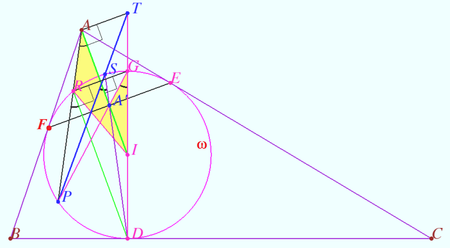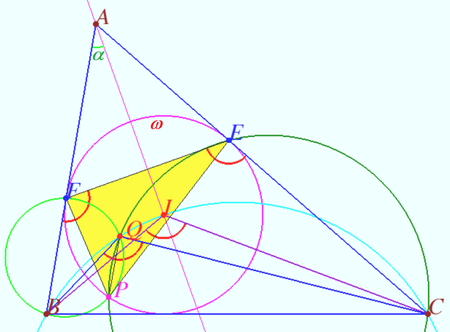Difference between revisions of "2019 IMO Problems/Problem 6"
(→Solution) |
(→Solution) |
||
| Line 31: | Line 31: | ||
We define <math>\angle BAC = 2 \alpha \implies \angle AFE = \angle AEF = 90^\circ – \alpha \implies</math> | We define <math>\angle BAC = 2 \alpha \implies \angle AFE = \angle AEF = 90^\circ – \alpha \implies</math> | ||
<math>\angle BFE = \angle CEF = 180^\circ – (90^\circ – \alpha) = 90^\circ + \alpha = \angle BIC</math> | <math>\angle BFE = \angle CEF = 180^\circ – (90^\circ – \alpha) = 90^\circ + \alpha = \angle BIC</math> | ||
| − | <math>(AI, BI,</math> and <math>CI</math> are bisectrices). | + | <math>(AI, BI,</math> and <math>CI</math> are bisectrices). |
| − | We use the Tangent-Chord Theorem and get < | + | |
| + | We use the Tangent-Chord Theorem and get <cmath>\angle EPF = \angle AEF = 90^\circ – \alpha.</cmath> | ||
<math>\angle BQC = \angle BQP + \angle PQC = \angle BFP + \angle CEP =</math> | <math>\angle BQC = \angle BQP + \angle PQC = \angle BFP + \angle CEP =</math> | ||
| − | <math>=\angle BFE – \angle EFP + \angle CEF – \angle FEP | + | <math>=\angle BFE – \angle EFP + \angle CEF – \angle FEP = 90^\circ + \alpha + 90^\circ + \alpha – (90^\circ + \alpha) = </math> |
| − | |||
<math>90^\circ + \alpha = \angle BIC \implies</math> | <math>90^\circ + \alpha = \angle BIC \implies</math> | ||
| − | + | Points <math>Q, B, I,</math> and <math>C</math> are concyclic. | |
Revision as of 12:09, 29 August 2022
Problem
Let ![]() be the incenter of acute triangle
be the incenter of acute triangle ![]() with
with ![]() . The incircle
. The incircle ![]() of
of ![]() is tangent to sides
is tangent to sides ![]() ,
, ![]() , and
, and ![]() at
at ![]() ,
, ![]() , and
, and ![]() , respectively. The line through
, respectively. The line through ![]() perpendicular to
perpendicular to ![]() meets
meets ![]() again at
again at ![]() . Line
. Line ![]() meets ω again at
meets ω again at ![]() . The circumcircles of triangles
. The circumcircles of triangles ![]() and
and ![]() meet again at
meet again at ![]() .
Prove that lines
.
Prove that lines ![]() and
and ![]() meet on the line through
meet on the line through ![]() perpendicular to
perpendicular to ![]() .
.
Solution
Step 1
We find an auxiliary point ![]()
Let ![]() be the antipode of
be the antipode of ![]() on
on ![]() where
where ![]() is radius
is radius ![]()
We define ![]()
![]() is cyclic
is cyclic ![]()
![]()
![]() An inversion with respect
An inversion with respect ![]() swap
swap ![]() and
and ![]() is the midpoint
is the midpoint ![]()
Let ![]() meets
meets ![]() again at
again at ![]() We define
We define ![]()
Opposite sides of any quadrilateral inscribed in the circle ![]() meet on the polar line of the intersection of the diagonals with respect to
meet on the polar line of the intersection of the diagonals with respect to ![]() and
and ![]() meet on the line through
meet on the line through ![]() perpendicular to
perpendicular to ![]() The problem is reduced to proving that
The problem is reduced to proving that ![]()
Step 2
We find a simplified way to define the point ![]()
We define ![]()
![]()
![]() and
and ![]() are bisectrices).
are bisectrices).
We use the Tangent-Chord Theorem and get ![]()
![]()
![]()
![]()
Points ![]() and
and ![]() are concyclic.
are concyclic.











